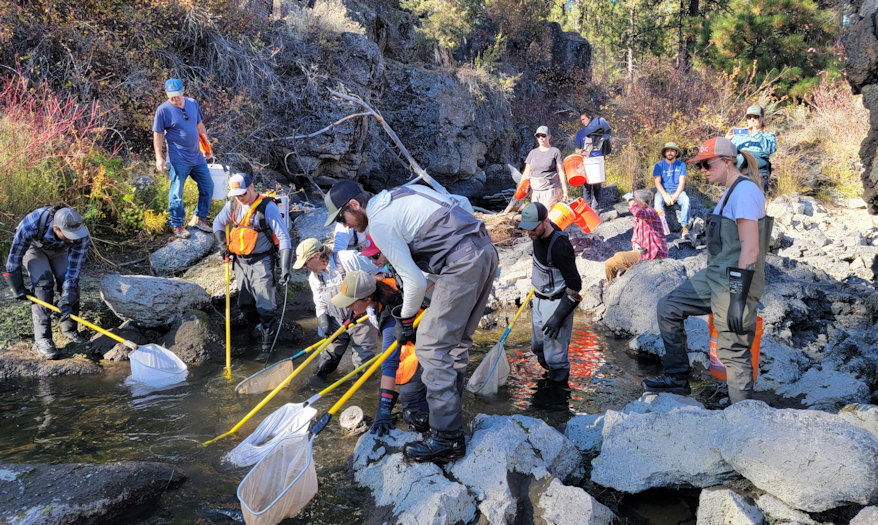Volunteers sought for annual fish rescue at Lava Island on Deschutes River – but it may not be needed in a few years

BEND, Ore. (KTVZ) -- The annual Lava Island Fish Rescue will kick off next Friday, October 18, and volunteers are urgently needed to assist in this important effort to save stranded fish, but organizers say ongoing Deschutes River restoration efforts may eliminate the need to do so within the next few years.
As Central Oregon's growing season winds down, local irrigation districts are reducing flows from Wickiup Dam to store water in the reservoir for next year’s irrigation season. Unfortunately, this reduction in flow causes side channels along the Deschutes River, including the one near Lava Island Falls, to dry up, stranding fish in isolated pools.
In response, the Deschutes River Conservancy, in partnership with the Deschutes Basin Board of Control and supported by technical experts from Mt. Hood Environmental, coordinates a volunteer-based rescue operation, a yearly effort that goes back a decade, to 2014. As in past years, volunteers will work to collect stranded fish from drying pools and relocate them to the main river channel.
“As river flows are reduced to store water for irrigation, downstream habitats are significantly impacted,” says Kate Fitzpatrick, Executive Director of the Deschutes River Conservancy. “Until we permanently restore flows through large-scale water conservation efforts, this rescue remains essential."
"By 2028 – or possibly sooner – we expect these rescues will no longer be needed, thanks to the streamflow restoration projects underway with our irrigation district partners,” she added.
The fish rescue involves volunteers wading into side channels to capture fish, hiking them in buckets to the main river, and assisting with species identification and fish counts.
This year’s operation will take place over three days, beginning on Friday, October 18, and continuing through Sunday, October 20. Volunteers can work half-day or full-day shifts in various roles based on their experience and comfort level in handling fish.
About this year’s rescue:
- Friday, October 18: Meet at Meadow Camp, Century Drive at 9 a.m.
- Saturday, October 19: AM shift meets at Meadow Camp. PM shift will meet at the Lava Island Boat Ramp.
- Sunday, October 20: Meet at Lava Island Boat Ramp.
Volunteers play a crucial role in this community effort, with tasks ranging from capturing fish in pools to transporting them and aiding in species identification. For safety and efficiency, volunteers need to be at least sixteen years old.
“The eight irrigation districts that make up the Deschutes Basin Board of Control have invested over $200,000 to support these rescue efforts while continuing our long-term work to restore river flows through canal piping, on-farm efficiencies and other conservation projects that provide reliable water and benefit the Deschutes River and endangered species,” said Craig Horrell, President of the Deschutes Basin Board of Control.
This rescue showcases the dedication of the Central Oregon community. “It’s inspiring to see so many people willing to trudge through mud and carry buckets to save fish,” says Fitzpatrick. “It’s a true testament to how much this community cares about the health of the Deschutes River.”
Those interested in volunteering are required to register through the DRC’s website: Volunteer Registration.
***Please note dates and times may change due to weather and river conditions. DRC will be in touch with all volunteers via text to provide updates.***
About the Deschutes River Conservancy:
The Deschutes River Conservancy (DRC) was formed in 1996 with a mission to restore streamflow and improve water quality in the Deschutes River Basin. The DRC has a multi-stakeholder board and, through collaborative efforts, has restored up to 350 CFS (equivalent to over 14 Olympic-sized swimming pools per hour) of flow in the basin with non-litigious, voluntary, and market-based programs. For more information about the DRC, visit www.deschutesriver.org.
About the Deschutes Basin Board of Control
The Deschutes Basin Board of Control (DBBC) consists of eight irrigation districts in Central Oregon, which convey critical water supplies to over 7,600 farm and ranch families, schools, and local parks.
Through the implementation of the Deschutes Basin Habitat Conservation Plan (HCP), the districts are committed to establishing water supply certainty for irrigators over the next 30 years while increasing instream flows in the Deschutes River, Crooked River, Whychus Creek, Tumalo Creek, and other smaller tributaries; improving habitat for the Oregon spotted frog, salmon, steelhead, and other fish and wildlife. The districts are actively piping open canals and improving on-farm efficiencies to enhance water reliability. To date, they have implemented over $53 million in projects, conserving 49 cubic feet per second (cfs) annually. Through a collaborative approach to water management, the irrigation districts aim to conserve an additional 229 cfs annually once all planned conservation projects are complete. For more information about the DBBC, visit www.dbbcirrigation.com.
